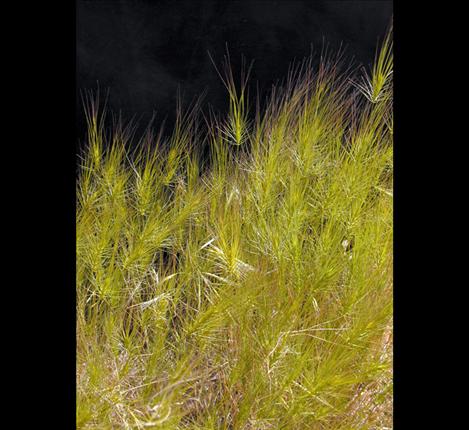Be on lookout for medusahead
Hey savvy news reader! Thanks for choosing local.
You are now reading
1 of 3 free articles.
ARLEE — Less than three months after it was first discovered near Arlee, a coalition of state, federal, tribal, county, municipal and private entities have declared war on medusahead rye, an aggressive invasive species with potential to damage native ecosystems and reduce rangeland carrying capacity.
An interagency effort to survey the extensiveness of the infestation is expected to begin in the spring, with an eradication plan to follow by the end of 2014.
“I think the threat is high, but the chances for managing this species and eradicating it are also very high,” said Jane Mangold, a rangeland weed specialist with MSU Extension and assistant professor in the Department of Land Resources and Environmental Sciences.
Medusahead is native to Eurasia, but arrived along the western coast of the United States in the 1880s. The annual plant has wiry awns that resemble the hair of its namesake Greek Gorgon. It germinates in the fall, overwinters, and blooms and dies in summer. Mangold and other biologists say the key to preventing medusahead from spreading is aggressive proactive measures. Medusahead has the capability to outcompete native foliage and another Eurasianic foreign invader with a track record of ecological destruction in the western United States: cheatgrass.
Medusahead presents an additional challenge that cheatgrass does not. Some animals and livestock will eat cheatgrass, but this is not the case with the silica-laden medusahead.
“Ranchers are especially concerned about it because it can displace native grasses that provide very good forage,” Mangold said. “This particular species is not very palatable for livestock. If it moves in and gets established, they tend to lose their good vegetation.”
Medusahead tends to thrive in areas where overgrazing or other factors have created a substantial amount of soil disturbance. The plant forms a dense litter layer that makes it difficult for other plants to grow.
Biologists and weed control specialists hope the size of the medusahead patch near Arlee is small enough that it can be stopped before it causes problems.
“What’s fortunate about finding something at this stage is that it’s not very established,” said Bryce Christiaens, weed control manager for Missoula County. Christiaens found the state’s first documented case of medusahead near his Arlee home this fall, along the Sanders-Lake County border. Christiaens estimated that the seed bank, or amount of seeds in the soil, of the infestation is less than three years old. Some patches of the plant were as large as a desk, Christiaens said. Initial survey efforts this spring could be key to making sure control efforts target every last plant.
“It’s going to be the least expensive now,” Christiaens said. “The biggest effort is going to be surveying similar sites to make sure we have all of it, rather than missing one or two patches and finding it again in two years.”
Response to the plant’s invasion has fallen to a coalition called Partners for Regional Invasive Species Management that consists of weed control units for Missoula, Sanders, and Lake counties, the Confederated Salish and Kootenai Tribes, Montana Fish Wildlife and Parks, and the U.S. Fish and Wildlife Service. Since 2008 the group has worked to fight rush skeleton weed and blue weed. The collaboration between the groups is invaluable, said Doug Dupuis, range specialist for the Confederated Salish and Kootenai Tribes.
“I don’t see any other way to do it,” Dupuis said. “You have to have the combined resources of agencies, their commitment and expertise. These species don’t respect agency boundaries.”
After initial surveys of the site are completed, a long-term management plan will be implemented. It could require chemical treatment, fire, tillage, or other eradication tactics, depending on the scope of the infestation.
As authorities begin to tackle the problem, they have asked that people educate themselves and their neighbors about what medusahead looks like so people can report it if it is found.
“We’ve had several people come into our office asking what it looks like,” said Kelsey Guffey, educator and assistant coordinator for Lake County Weed Control District. “A lot of people are really conscientious.”
To learn more about the plant visit www.mtweed.org.
Anyone who detects the plant should contact the CSKT Lands Department at (406) 676-2700, Ext. 1240; Lake County Weed Control at (406) 883-7330; Sanders County Weed Department at (406)826-3487; or Missoula County Weed Control at (406) 258-4200.
















